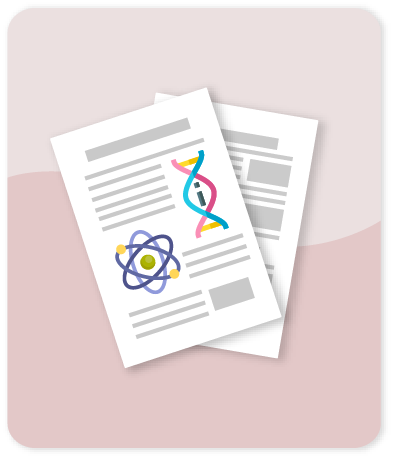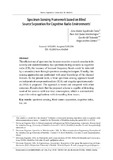Mostrar el registro sencillo del ítem
Método para sensado del espectro basado en separación ciega de fuentes para ambientes de radio cognitiva
Spectrum Sensing Framework based on Blind Source Separation for Cognitive Radio Environments
| dc.contributor.author | Sepúlveda Cano, Lina María | |
| dc.contributor.author | Quiza Montealegre, Jhon Jair | |
| dc.contributor.author | Gil Taborda, Camilo | |
| dc.contributor.author | Gómez García, Jorge Andrés | |
| dc.date.accessioned | 2017-06-29T22:22:35Z | |
| dc.date.available | 2017-06-29T22:22:35Z | |
| dc.date.created | 2016-12-31 | |
| dc.identifier.issn | 1692-3324 | |
| dc.identifier.uri | http://hdl.handle.net/11407/3541 | |
| dc.description.abstract | El uso eficiente del espectro se ha convertido en un área de investigación activa, debido a la escasez de este recurso y a su subutilización. En un escenario en el que el espectro es un recurso compartido como en la radio cognitiva (CR), los espacios sin uso dentro de las bandas de frecuencias con licencia podrían ser detectados y posteriormente utilizados por un usuario secundario a través de técnicas de detección y sensado del espectro. Generalmente, estas técnicas de detección se utilizan a partir de un conocimiento previo de las características de canal. En el presente trabajo se propone un enfoque de detección ciega del espectro basado en análisis de componentes independientes (ICA) y análisis de espectro singular (SSA). La técnica de detección se valida a través de simulación, y su desempeño se compara con metodologías propuestas por otros autores en la literatura. Los resultados muestran que el sistema propuesto es capaz de detectar la mayoría de las fuentes con bajo consumo de tiempo, un aspecto que cabe resaltar para aplicaciones en línea con exigencias de tiempo. | spa |
| dc.description.abstract | The efficient use of spectrum has become an active research area, due to its scarcity and underutilization. In a spectrum sharing scenario as Cognitive Radio (CR), the vacancy of licensed frequency bands could be detected by a secondary user through spectrum sensing techniques. Usually, this sensing approaches are performed with a priori knowledge of the channel features. In the present work, a blind spectrum sensing approach based on Independent Component Analysis and Singular Spectrum Analysis is proposed. The approach is tested and compared with other outcomes. Results show that the proposed scheme is capable of detect most of the sources with low time consumption, which is a remarkable aspect for online applications with demanding time issues. | spa |
| dc.format.extent | p. 129-140 | spa |
| dc.format.medium | Electrónico | spa |
| dc.format.mimetype | application/pdf | |
| dc.language.iso | spa | |
| dc.publisher | Universidad de Medellín | spa |
| dc.relation.uri | http://revistas.udem.edu.co/index.php/ingenierias/article/view/1491 | |
| dc.rights.uri | http://creativecommons.org/licenses/by-nc-sa/4.0/ | * |
| dc.source | Revista Ingenierías Universidad de Medellín; Vol. 15, núm. 29 (2016); 129-140 | spa |
| dc.source | 2248-4094 | spa |
| dc.source | 1692-3324 | spa |
| dc.subject | Spectrum sensing | spa |
| dc.subject | Blind source separation | spa |
| dc.subject | Cognitive Radio | spa |
| dc.subject | ICA | spa |
| dc.subject | SSA | spa |
| dc.subject | Sensado del espectro | spa |
| dc.subject | Separación ciega de fuentes | spa |
| dc.subject | Radio cognitiva | spa |
| dc.subject | ICA | spa |
| dc.subject | SSA | spa |
| dc.title | Método para sensado del espectro basado en separación ciega de fuentes para ambientes de radio cognitiva | spa |
| dc.title | Spectrum Sensing Framework based on Blind Source Separation for Cognitive Radio Environments | spa |
| dc.type | Article | eng |
| dc.rights.accessrights | info:eu-repo/semantics/openAccess | |
| dc.identifier.doi | http://dx.doi.org/10.22395/rium.v15n29a8 | |
| dc.relation.citationvolume | 15 | |
| dc.relation.citationissue | 29 | |
| dc.relation.citationstartpage | 129 | |
| dc.relation.citationendpage | 140 | |
| dc.audience | Comunidad Universidad de Medellín | spa |
| dc.publisher.faculty | Facultad de Ingenierías | spa |
| dc.coverage | Lat: 06 15 00 N degrees minutes Lat: 6.2500 decimal degreesLong: 075 36 00 W degrees minutes Long: -75.6000 decimal degrees | spa |
| dc.publisher.place | Medellín | spa |
| dc.creator.affiliation | Sepúlveda Cano, Lina María; Universidad de Medellín | spa |
| dc.creator.affiliation | Quiza Montealegre, Jhon Jair; Universidad de Medellín | spa |
| dc.creator.affiliation | Gil Taborda, Camilo; Universidad de Medellín | spa |
| dc.creator.affiliation | Gómez García, Jorge Andrés; Universidad Politécnica de Madrid | spa |
| dc.relation.references | M. Sarijari, A. Marwanto, N. Fisal, S. K. S. Yusof, R. Rashid & M. Satria, “Energy detection sensing based on gnu radio and usrp: An analysis study”, in Proceedings of the 2009 IEEE 9th Malaysia International Conference on Communications, Kuala Lumpur, Malaysia, Dec. 15-17, 2009, pp. 338-342. Available: https://pdfs.semanticscholar.org/2319/11ca01bab559aed17bd745bb6ae4c97a8d70.pdf. | spa |
| dc.relation.references | Y. Hassan, M. El-Tarhuni & K. Assaleh, “Learning-based spectrum sensing for cognitive radio systems”, Journal of Computer Networks and Communications, vol. 2012, pp. 1-14, 2012. Available: https://www.hindawi.com/journals/jcnc/2012/259824/ | spa |
| dc.relation.references | A. Mate, K. H. Lee & I. T. Lu, “Spectrum sensing based on time covariance matrix using gnu radio and usrp for cognitive radio”, in: 2011 ieee Long Island Systems, Applications and Technology Conference (lisat), Farmingdale, NY, USA, May 6, 2011, pp. 1-6. | spa |
| dc.relation.references | G. Nautiyal & R. Kumar, “Spectrum sensing in cognitive radio using matlab”, International Journal of Engineering and Advanced Technology (IJEAT), vol. 2, no. 5, pp. 529-532, Jun. 2013. | spa |
| dc.relation.references | Z. Xuping & P. Jianguo, “Energy-detection based spectrum sensing for cognitive radio”, in iet Conference on Wireless, Mobile and Sensor Networks (ccwmsn07), Shangai, China, Dec. 12-14, 2007, pp. 944-947. | spa |
| dc.relation.references | H. Arslan, Cognitive Radio, Software Defined Radio, and Adaptive Wireless Systems (Signals and Communication Technology). New York: Springer-Verlag, 2007. | spa |
| dc.relation.references | M. Rahman, A. Haniz, S. Khadka, S., Iswandi, Gahadza, M., Kim, M., ichi Takada, J. “Development of spectrum sensing system with gnu radio and usrp to detect emergency radios”, ieice, The Institute of Electronics, Information and Communication Engineers, Sendai, Japan, Technical Report SR2009-57, Oct. 2009. | spa |
| dc.relation.references | A. Fehske, J. Gaeddert & J. Reed, “A new approach to signal classification using spectral correlation and neural networks”, in DySPAN 2005. First IEEE International Symposium on New Frontiers in Dynamic Spectrum Access Networks, Baltimore, USA, Nov. 8-11, 2005. pp. 144-150. | spa |
| dc.relation.references | S. Chaudhari, “Spectrum sensing for cognitive radios: Algorithms, performance, and limitations”, Ph. D. thesis, Aalto University, Greater Helsinki, Finland, 2012. | spa |
| dc.relation.references | S. Da, G. Xiaoying, C. Hsiao-hwa & Q. Liang, “Fast cycle frequency domain feature detection for cognitive radio systems”, Arxiv, p. 4, Ar. 6, 2009. Available: https://archive.org/details/arxiv-0903.1183 | spa |
| dc.relation.references | M. Calabro, “A Cooperative Spectrum Sensing Network with Signal Classification Capabilities”. Ph. D. thesis, Worcester Polytechnic Institute, Worcester, Massachusetts, 2010. | spa |
| dc.relation.references | A. G. Ferrer, E.G. Prieto & D. Peña, “Exploring ica for time series decomposition”, Working Paper 11-16, Statistics and Econometrics Series 11, May 2011. Available: http://orff.uc3m.es/bitstream/handle/10016/11285/ws111611.pdf?sequence=1 | spa |
| dc.relation.references | L. Molgedey & H. G. Schuster, “Separation of a mixture of independent signals using time delayed correlations”, Physical Review Letters, vol. 72, 3634-3637, 1994. | spa |
| dc.relation.references | V. Krishnaveni, S. Jayaraman, P. M. Kumar, K. Shivakumar & K. Ramadoss, “Comparison of independent component analysis algorithms for removal of ocular artifacts from electroencephalogram”, Meas. Sci. Rev. J, vol. 5, no. 2, pp. 67-78, 2005. | spa |
| dc.relation.references | Hongli, Sun, Y.: “The study and test of ica algorithms”, in 2005 Proceedings International Conference on Wireless Communications, Networking and Mobile Computing, vol. 1, Wuhan, China, Sept. 23-26, 2005, pp. 602-605. | spa |
| dc.relation.references | T. Kolenda, L. K. Hansen & J. Larsen, “Signal detection using ica: Application to chat room topic spotting”, in 3rd International Conference on Independent Component Analysis and Blind Source Separation, ica’2001, San Diego, USA, Dec. 9-13, 2001, pp. 540-545. Available: http://cogsys.imm.dtu.dk/publications/2001/kolenda.ica2001.pdf | spa |
| dc.relation.references | H. G. Ma, Q. B. Jiang, Z. Q. Liu, G. Liu & Z. Y. Ma, “A novel blind source separation method for single-channel signal”, Signal Processing, vol. 90, no. 12, pp. 3232-3241, 2010. | spa |
| dc.relation.references | S. S. Kalamkar & A. Banerjee, “On the performance of generalized energy detector under noise uncertainty in cognitive radio”, in National Conference on Communications (ncc), Delhi, India, Feb. 15-17, 2013. pp. 1–5. | spa |
| dc.rights.creativecommons | Attribution-NonCommercial-ShareAlike 4.0 International | * |
| dc.identifier.eissn | 2248-4094 | |
| dc.type.coar | http://purl.org/coar/resource_type/c_6501 | |
| dc.type.version | info:eu-repo/semantics/publishedVersion | |
| dc.type.local | Artículo científico | spa |
| dc.type.driver | info:eu-repo/semantics/article | |
| dc.identifier.reponame | reponame:Repositorio Institucional Universidad de Medellín | spa |
| dc.identifier.repourl | repourl:https://repository.udem.edu.co/ | |
| dc.identifier.instname | instname:Universidad de Medellín | spa |
| dc.relation.ispartofjournal | Revista Ingenierías Universidad de Medellín | spa |



